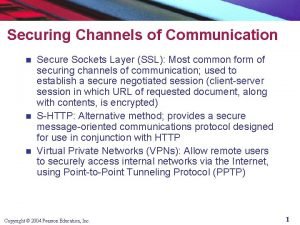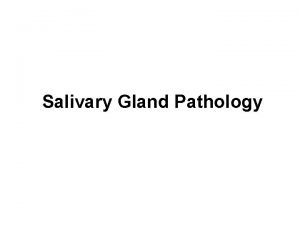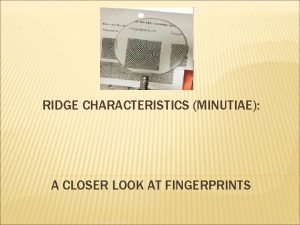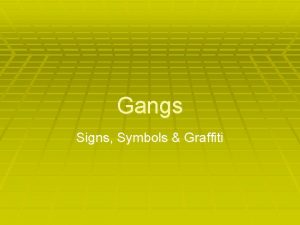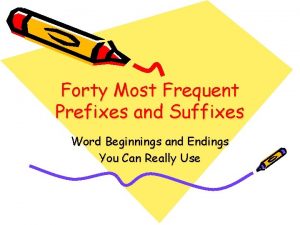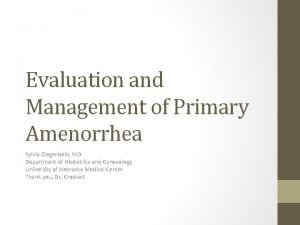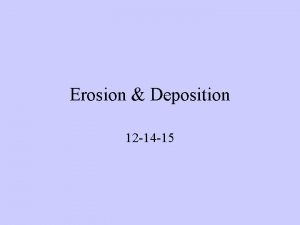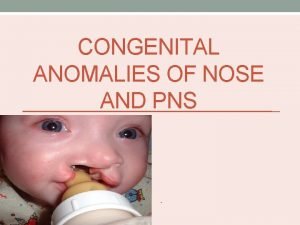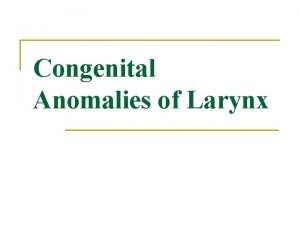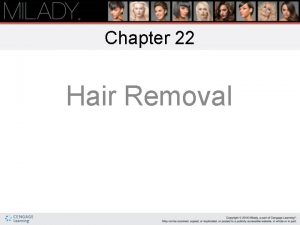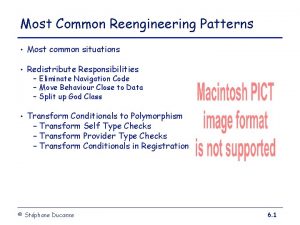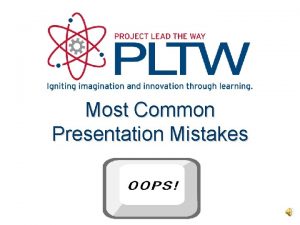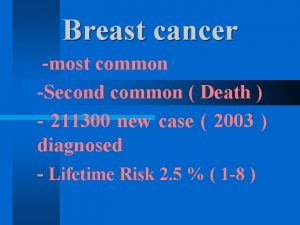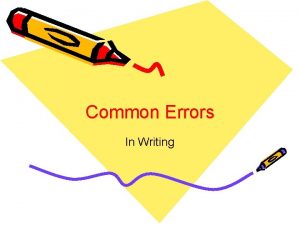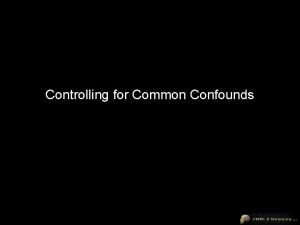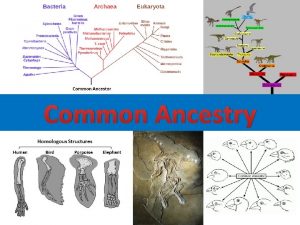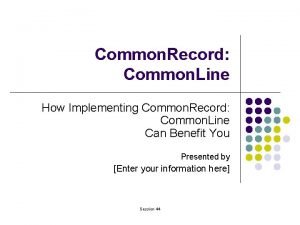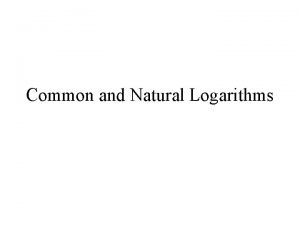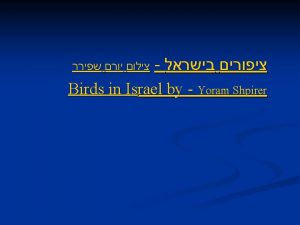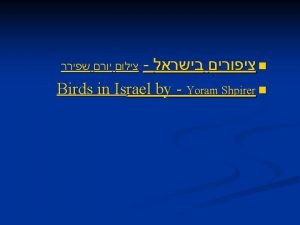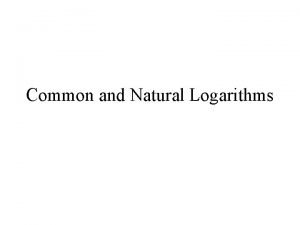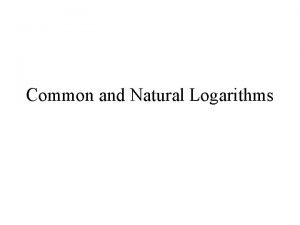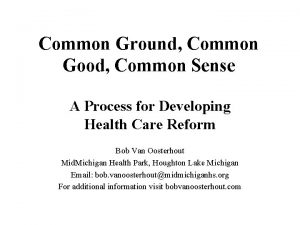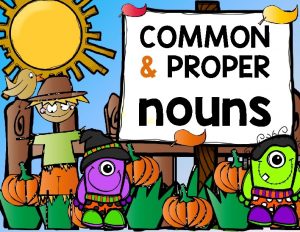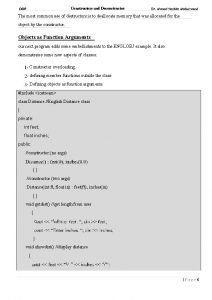What is the most common use of the




























- Slides: 28

What is the most common use of the “reverse split” function of a VHF/UHF transceiver? A. Reduce power output B. Increase power output C. Listen on a repeater’s input frequency D. Listen on a repeater’s output frequency T 2 B 01 HRLM (6 - 6)

What is the most common use of the “reverse split” function of a VHF/UHF transceiver? A. Reduce power output B. Increase power output C. Listen on a repeater’s input frequency D. Listen on a repeater’s output frequency (C) T 2 B 01 HRLM (6 - 6)

What term describes the use of a sub-audible tone transmitted along with normal voice audio to open the squelch of a receiver? A. Carrier squelch B. Tone burst C. DTMF D. CTCSS T 2 B 02 HRLM (6 - 13)

What term describes the use of a sub-audible tone transmitted along with normal voice audio to open the squelch of a receiver? A. Carrier squelch B. Tone burst C. DTMF D. CTCSS (D) T 2 B 02 HRLM (6 - 13)

If a station is not strong enough to keep a repeater’s receiver squelch open, which of the following might allow you to receive the station’s signal? A. Open the squelch on your radio B. Listen on the repeater input frequency C. Listen on the repeater output frequency D. Increase your transmit power T 2 B 03 HRLM (6 - 6)

If a station is not strong enough to keep a repeater’s receiver squelch open, which of the following might allow you to receive the station’s signal? A. Open the squelch on your radio B. Listen on the repeater input frequency C. Listen on the repeater output frequency D. Increase your transmit power (B) T 2 B 03 HRLM (6 - 6)

Which of the following could be the reason you are unable to access a repeater whose output you can hear? A. Improper transceiver offset B. The repeater may require a proper CTCSS tone from your transceiver C. The repeater may require a proper DCS tone from your transceiver D. All of these choices are correct T 2 B 04 HRLM (6 - 13)

Which of the following could be the reason you are unable to access a repeater whose output you can hear? A. Improper transceiver offset B. The repeater may require a proper CTCSS tone from your transceiver C. The repeater may require a proper DCS tone from your transceiver D. All of these choices are correct (D) T 2 B 04 HRLM (6 - 13)

What might be the problem if a repeater user says your transmissions are breaking up on voice peaks? A. You have the incorrect offset B. You need to talk louder C. You are talking too loudly D. Your transmit power is too high T 2 B 05 HRLM (5 - 8)

What might be the problem if a repeater user says your transmissions are breaking up on voice peaks? A. You have the incorrect offset B. You need to talk louder C. You are talking too loudly D. Your transmit power is too high (C) T 2 B 05 HRLM (5 - 8)

What type of tones are used to control repeaters linked by the Internet Relay Linking Project (IRLP) protocol? A. DTMF B. CTCSS C. Echo. Link D. Sub-audible T 2 B 06 HRLM (6 - 15)

What type of tones are used to control repeaters linked by the Internet Relay Linking Project (IRLP) protocol? A. DTMF B. CTCSS C. Echo. Link D. Sub-audible (A) T 2 B 06 HRLM (6 - 15)

How can you join a digital repeater’s “talk group”? A. Register your radio with the local FCC office B. Join the repeater owner’s club C. Program your radio with the group’s ID or code D. Sign your call after the courtesy tone T 2 B 07 HRLM (6 - 15)

How can you join a digital repeater’s “talk group”? A. Register your radio with the local FCC office B. Join the repeater owner’s club C. Program your radio with the group’s ID or code D. Sign your call after the courtesy tone (C) T 2 B 07 HRLM (6 - 15)

Which of the following applies when two stations transmitting on the same frequency interfere with each other? A. Common courtesy should prevail, but no one has absolute right to an amateur frequency B. Whoever has the strongest signal has priority on the frequency C. Whoever has been on the frequency the longest has priority on the frequency D. The station that has the weakest signal has priority on the frequency T 2 B 08 HRLM (8 - 6)

Which of the following applies when two stations transmitting on the same frequency interfere with each other? A. Common courtesy should prevail, but no one has absolute right to an amateur frequency B. Whoever has the strongest signal has priority on the frequency C. Whoever has been on the frequency the longest has priority on the frequency D. The station that has the weakest signal has priority on the frequency (A) T 2 B 08 HRLM (8 - 6)

What is a “talk group” on a DMR digital repeater? A. A group of operators sharing common interests B. A way for groups of users to share a channel at different times without being heard by other users on the channel C. A protocol that increases the signal-to-noise ratio when multiple repeaters are linked together D. A net that meets at a particular time T 2 B 09 HRLM (6 - 15)

What is a “talk group” on a DMR digital repeater? A. A group of operators sharing common interests B. A way for groups of users to share a channel at different times without being heard by other users on the channel C. A protocol that increases the signal-to-noise ratio when multiple repeaters are linked together D. A net that meets at a particular time (B) T 2 B 09 HRLM (6 - 15)

Which Q signal indicates that you are receiving interference from other stations? A. QRM B. QRN C. QTH D. QSB T 2 B 10 HRLM (6 - 7)

Which Q signal indicates that you are receiving interference from other stations? A. QRM B. QRN C. QTH D. QSB (A) T 2 B 10 HRLM (6 - 7)

Which Q signal indicates that you are changing frequency? A. QRU B. QSY C. QSL D. QRZ T 2 B 11 HRLM (6 - 7)

Which Q signal indicates that you are changing frequency? A. QRU B. QSY C. QSL D. QRZ (B) T 2 B 11 HRLM (6 - 7)

Why are simplex channels designated in the VHF/UHF band plans? A. So that stations within mutual communications range can communicate without tying up a repeater B. For contest operation C. For working DX only D. So that stations with simple transmitters can access the repeater without automated offset T 2 B 12 HRLM (6 - 6)

Why are simplex channels designated in the VHF/UHF band plans? A. So that stations within mutual communications range can communicate without tying up a repeater B. For contest operation C. For working DX only D. So that stations with simple transmitters can access the repeater without automated offset (A) T 2 B 12 HRLM (6 - 6)

Where may SSB phone be used in amateur bands above 50 MHz? A. Only in sub-bands allocated to General class or higher licensees B. Only on repeaters C. In at least some portion of all these bands D. On any band as long as power is limited to 25 watts T 2 B 13 HRLM (6 - 2)

Where may SSB phone be used in amateur bands above 50 MHz? A. Only in sub-bands allocated to General class or higher licensees B. Only on repeaters C. In at least some portion of all these bands D. On any band as long as power is limited to 25 watts (C) T 2 B 13 HRLM (6 - 2)

Which of the following describes a linked repeater network? A. A network of repeaters where signals received by one repeater are repeated by all the repeaters B. A repeater with more than one receiver C. Multiple repeaters with the same owner D. A system of repeaters linked by APRS T 2 B 14 HRLM (6 - 12)

Which of the following describes a linked repeater network? A. A network of repeaters where signals received by one repeater are repeated by all the repeaters B. A repeater with more than one receiver C. Multiple repeaters with the same owner D. A system of repeaters linked by APRS (A) T 2 B 14 HRLM (6 - 12)
 Lcm for 4 and 12
Lcm for 4 and 12 Common anode and common cathode
Common anode and common cathode Factor tree of 28
Factor tree of 28 Lowest common factor
Lowest common factor What is the least common multiple of 18 and 27
What is the least common multiple of 18 and 27 Highest common factors and lowest common multiples
Highest common factors and lowest common multiples Most common pay periods
Most common pay periods Most common site of urethral injury
Most common site of urethral injury Data input techniques in gis
Data input techniques in gis Common lit the most dangerous game
Common lit the most dangerous game Routine message
Routine message The most common form of securing channels is through.
The most common form of securing channels is through. Salivary gland pathology
Salivary gland pathology Characteristics of ridge
Characteristics of ridge Periodic table of elements families
Periodic table of elements families Most common site of ureteric injury during hysterectomy
Most common site of ureteric injury during hysterectomy Give 9 most common parts of a securement system
Give 9 most common parts of a securement system Fingerprints characteristics
Fingerprints characteristics S gang sign
S gang sign 100 prefix words
100 prefix words Swyer syndrome
Swyer syndrome Esker
Esker Longest czech word without vowels
Longest czech word without vowels Dexamethasone suppression test
Dexamethasone suppression test What is the most common crime in india
What is the most common crime in india Mcgovern nipple
Mcgovern nipple Most common congenital anomalies
Most common congenital anomalies How do clouds form
How do clouds form What are the most frequent hair removal requests from men?
What are the most frequent hair removal requests from men?











